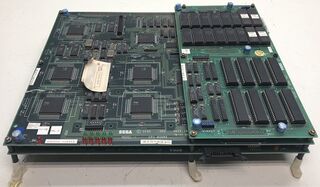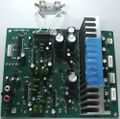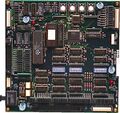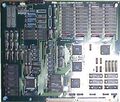Difference between revisions of "Sega Model 1"
From Sega Retro
| Line 19: | Line 19: | ||
* Main [[wikipedia:Central processing unit|CPU]]: [[NEC]] [[wikipedia:NEC V60|V60]] @ 16 MHz | * Main [[wikipedia:Central processing unit|CPU]]: [[NEC]] [[wikipedia:NEC V60|V60]] @ 16 MHz | ||
** [[wikipedia:Fixed-point arithmetic|Fixed-point arithmetic]]: [[wikipedia:32-bit|32-bit]] [[wikipedia:Reduced instruction set computing|RISC]]{{ref|http://www.system16.com}} [[wikipedia:Instruction set|instructions]] @ 3.5 [[wikipedia:Instructions per second|MIPS]] (million instructions per second){{ref|http://id.nii.ac.jp/1001/00059745/}}{{ref|http://archive.computerhistory.org/resources/access/text/2013/04/102723432-05-01-acc.pdf}} | ** [[wikipedia:Fixed-point arithmetic|Fixed-point arithmetic]]: [[wikipedia:32-bit|32-bit]] [[wikipedia:Reduced instruction set computing|RISC]]{{ref|http://www.system16.com}} [[wikipedia:Instruction set|instructions]] @ 3.5 [[wikipedia:Instructions per second|MIPS]] (million instructions per second){{ref|http://id.nii.ac.jp/1001/00059745/}}{{ref|http://archive.computerhistory.org/resources/access/text/2013/04/102723432-05-01-acc.pdf}} | ||
| − | ** [[Floating-point unit]]: [[Single-precision floating-point format|32-bit]] and [[Double-precision floating-point format|64-bit operations]]{{ref|http://multimedia.cx/NEC_V60pgmRef.pdf}} | + | ** [[wikipedia:Floating-point unit|Floating-point unit]]: [[wikipedia:Single-precision floating-point format|32-bit]] and [[wikipedia:Double-precision floating-point format|64-bit operations]]{{ref|http://multimedia.cx/NEC_V60pgmRef.pdf}} |
| − | * [[Video card|Graphics board]]: Sega 837-7894 171-6080D VIDEO [[Printed circuit board|PCB]]{{ref|https://github.com/mamedev/mame/tree/master/src/mame/drivers/model1.c}} | + | * [[wikipedia:Video card|Graphics board]]: Sega 837-7894 171-6080D VIDEO [[wikipedia:Printed circuit board|PCB]]{{ref|https://github.com/mamedev/mame/tree/master/src/mame/drivers/model1.c}} |
| − | * [ | + | * [http://gaming.wikia.com/wiki/Graphics_processing_unit GPU] [[wikipedia:Coprocessor|coprocessors]]: 5× [[Fujitsu]] TGP MB86233{{ref|http://members.iinet.net.au/~lantra9jp1/gurudumps/m2status/index.html}} ([[wikipedia:Geometry pipelines|geometrizer]], [[wikipedia:Rasterisation|rasterizer]],{{ref|http://web.archive.org/web/20130104200817/http://mamedev.org/source/src/mame/video/model1.c.html}} [[wikipedia:Digital signal processor|DSP]], [[wikipedia:Floating point unit|FPU]]) |
| − | ** Coprocessor abilities: [[Decimal floating point|Floating decimal point]] operation function, axis rotation operation function, [ | + | ** Coprocessor abilities: [[wikipedia:Decimal floating point|Floating decimal point]] operation function, axis rotation operation function, [http://gaming.wikia.com/wiki/Three-dimensional 3D] [[wikipedia:Matrix (mathematics)|matrix operation]] function{{ref|http://www.system16.com}} |
| − | ** Floating-point unit: 32-bit operations @ 16 MFLOPS ([[Mega-]][ | + | ** Floating-point unit: 32-bit operations @ 16 MFLOPS ([[wikipedia:Mega-]][http://gaming.wikia.com/wiki/Instructions_per_second FLOPS]){{ref|http://www.system16.com}}{{ref|http://www.consoledatabase.com/faq/segasaturn/segasaturnfaq.txt}} each (80 MFLOPS combined) |
* Sound CPU: [[Motorola 68000]] @ 12 MHz{{ref|http://www.system16.com}} | * Sound CPU: [[Motorola 68000]] @ 12 MHz{{ref|http://www.system16.com}} | ||
* Sound chips: 2× Sega 315-5560 Custom MultiPCM{{ref|http://www.system16.com}} | * Sound chips: 2× Sega 315-5560 Custom MultiPCM{{ref|http://www.system16.com}} | ||
** Audio capabilities: 28 [[Pulse-code modulation|PCM]] channels per chip (one for music, one for sound effects), 56 PCM channels total | ** Audio capabilities: 28 [[Pulse-code modulation|PCM]] channels per chip (one for music, one for sound effects), 56 PCM channels total | ||
| − | * Sound timer: [[ | + | * Sound timer: [[Yamaha]] YM3834 @ 8 MHz |
| − | * [[Random-access memory|RAM]]: 1936 KB (1880 KB SRAM){{ref|https://github.com/mamedev/mame/tree/master/src/mame/drivers/model1.c}} | + | * [[wikipedia:Random-access memory|RAM]]: 1936 KB (1880 KB SRAM){{ref|https://github.com/mamedev/mame/tree/master/src/mame/drivers/model1.c}} |
| − | ** Main [[Static random-access memory|SRAM]]: 408 KB | + | ** Main [[wikipedia:Static random-access memory|SRAM]]: 408 KB |
| − | ** [[Video memory]]: 1464 KB SRAM (192 KB [[display list]], 576 KB [[Tiled rendering|tiles]], 64 KB colors) | + | ** [[wikipedia:Video memory|Video memory]]: 1464 KB SRAM (192 KB [[wikipedia:Display list|display list]], 576 KB [[wikipedia:Tiled rendering|tiles]], 64 KB colors) |
** Audio memory: 64 KB (8 KB SRAM) | ** Audio memory: 64 KB (8 KB SRAM) | ||
| − | * Monitor [ | + | * Monitor [http://gaming.wikia.com/wiki/Display_resolution display resolution]: 496×384 pixels, 24 kHz [[wikipedia:Horizontal scan rate|horizontal sync]],{{ref|https://github.com/mamedev/mame/tree/master/src/mame/drivers/model1.c}} 60 Hz [[wikipedia:Refresh rate|refresh rate]], [[wikipedia:Progressive scan|progressive scan]] (non-interlaced) |
| − | * [[Frame rate]]: 60 frames per second{{ref|http://vintage3d.org/history.php#sthash.Wlg79A2P.dpbs}} | + | * [[wikipedia:Frame rate|Frame rate]]: 60 frames per second{{ref|http://vintage3d.org/history.php#sthash.Wlg79A2P.dpbs}} |
| − | * [ | + | * [http://gaming.wikia.com/wiki/List_of_color_palettes Color palette]: 16,777,216 ([http://gaming.wikia.com/wiki/List_of_RGB_palettes#16-bit_RGB 16-bit] [[wikipedia:high color|high color]] [[wikipedia:Color depth|depth]]{{ref|http://www.system16.com}} and 256 luminance levels){{ref|http://web.archive.org/web/20130104200817/http://mamedev.org/source/src/mame/video/model1.c.html}} |
* Colors on screen: 190,464 (496×384) | * Colors on screen: 190,464 (496×384) | ||
| − | * Graphical capabilities: [[Shading]], [ | + | * Graphical capabilities: [[wikipedia:Shading|Shading]], [http://www.giantbomb.com/flat-shading/3015-2277/ flat shading], [[wikipedia:Diffuse reflection|diffuse reflection]], [[wikipedia:Specular reflection|specular reflection]], 2 layers of background [[wikipedia:Scrolling|scrolling]], [[wikipedia:Alpha blending|alpha blending]], [[wikipedia:Alpha compositing|alpha channel]],{{ref|http://www.system16.com}} [[wikipedia:Computer graphics lighting|lighting]]{{ref|http://web.archive.org/web/20130104200817/http://mamedev.org/source/src/mame/video/model1.c.html}} |
| − | * [[Digital geometry|Geometric]] performance: 180,000 [ | + | * [[wikipedia:Digital geometry|Geometric]] performance: 180,000 [http://gaming.wikia.com/wiki/Three-dimensional polygons]/sec (with all effects), 540,000 [http://gaming.wikia.com/wiki/Vector_graphics vectors]/sec{{ref|http://www.system16.com}} |
| − | * Rendering [[fillrate]]: 1,200,000 [[pixel]]s/sec{{ref|http://www.system16.com}} | + | * Rendering [[wikipedia:Fillrate|fillrate]]: 1,200,000 [[pixel]]s/sec{{ref|http://www.system16.com}} |
==List of Sega Model 1 Games== | ==List of Sega Model 1 Games== | ||
Revision as of 21:31, 21 February 2015

| |||||
| Sega Model 1 | |||||
|---|---|---|---|---|---|
| Manufacturer: Sega | |||||
|
The Sega Model 1 is an arcade system board released by Sega in 1992. It is the successor to the Sega System 32 arcade boards, and was succeeded by the Sega Model 2 series. It was Sega's first hardware designed for 3D polygon graphics.
Originally, the Model 1 was simply known as the CG Board, but was retroactively given the Model 1 name after work on the Model 2 began.
Hardware
It began development in 1990,[1] and released in 1992. The Model 1 was intended to compete with Namco's System 21; Namco was then the market leader in polygonal 3D video games, with titles such as Galaxian³ and Starblade.[2] While it was a significant improvement over the System 21, the Model 1 hardware was expensive, and only a few games were developed for the platform.
Technical Specifications
- Main CPU: NEC V60 @ 16 MHz
- Fixed-point arithmetic: 32-bit RISC[3] instructions @ 3.5 MIPS (million instructions per second)[4][5]
- Floating-point unit: 32-bit and 64-bit operations[6]
- Graphics board: Sega 837-7894 171-6080D VIDEO PCB[7]
- GPU coprocessors: 5× Fujitsu TGP MB86233[8] (geometrizer, rasterizer,[9] DSP, FPU)
- Coprocessor abilities: Floating decimal point operation function, axis rotation operation function, 3D matrix operation function[3]
- Floating-point unit: 32-bit operations @ 16 MFLOPS (wikipedia:Mega-FLOPS)[3][10] each (80 MFLOPS combined)
- Sound CPU: Motorola 68000 @ 12 MHz[3]
- Sound chips: 2× Sega 315-5560 Custom MultiPCM[3]
- Audio capabilities: 28 PCM channels per chip (one for music, one for sound effects), 56 PCM channels total
- Sound timer: Yamaha YM3834 @ 8 MHz
- RAM: 1936 KB (1880 KB SRAM)[7]
- Main SRAM: 408 KB
- Video memory: 1464 KB SRAM (192 KB display list, 576 KB tiles, 64 KB colors)
- Audio memory: 64 KB (8 KB SRAM)
- Monitor display resolution: 496×384 pixels, 24 kHz horizontal sync,[7] 60 Hz refresh rate, progressive scan (non-interlaced)
- Frame rate: 60 frames per second[11]
- Color palette: 16,777,216 (16-bit high color depth[3] and 256 luminance levels)[9]
- Colors on screen: 190,464 (496×384)
- Graphical capabilities: Shading, flat shading, diffuse reflection, specular reflection, 2 layers of background scrolling, alpha blending, alpha channel,[3] lighting[9]
- Geometric performance: 180,000 polygons/sec (with all effects), 540,000 vectors/sec[3]
- Rendering fillrate: 1,200,000 pixels/sec[3]
List of Sega Model 1 Games
- Star Wars Arcade (1993)
- Virtua Racing (1992)
- Virtua Fighter (1993)
- Wing War (1994)
Gallery
| Sega arcade boards |
|---|
| Originating in arcades |
|
77
78
79
80
81
82
83
84
85
86
87
88
89
90
91
92
93
94
95
96
97
98
99
|
| Console-based hardware |
|
84
85
86
87
88
89
90
91
92
93
94
95
96
97
98
99
00
01
02
03
04
05
06
07
08
09
10
11
12
13
14
|
| PC-based hardware |
|
05
06
07
08
09
10
11
12
13
14
15
16
17
18
19
20
21
22
23
|






